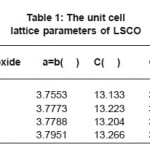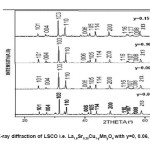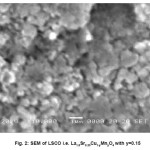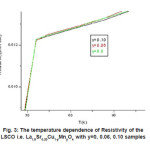Manish Verma1*, N. P. Lalla2, D. M. Phase2 and V. K. Ahire2
1University of Lucknow, Department of Physics, Lucknow - 226 007, India.
2Ugc-Dae Csr, Indore, University Campus, Khandwa Road, Indore - 452 017, India.
DOI : http://dx.doi.org/10.13005/msri/080113
Article Publishing History
Article Received on : 20 Apr 2011
Article Accepted on : 29 May 2011
Article Published :
Plagiarism Check: No
Article Metrics
ABSTRACT:
Polycrystalline samples of La1.8Sr0.20Cu1-yMnyO4 (0≤y≤0.15) were synthesized by solid state reaction method. The phase purity was confirmed by powder X-ray diffraction. The scanning electron microscopy was done on the La1.8Sr0.20Cu1-yMnyO4 (0≤y≤0.15) samples. The superconductivity and Transition temperature were studied by four probe resistivity temperature method. The transition temperatures were measured nearly 37 k and were unchanged on Mn doping at Cu site in La1.8Sr0.20CuO4.
KEYWORDS:
Solid state reaction method; X-ray diffraction; Scanning electron microscopy; Microstructure; SEM; Transition temperature; LSCO; Resistivity.
Copy the following to cite this article:
Verma M, Lalla N. P, Phase D. M, Ahire V. K. Synthesis Growth and Characterization of Mn Doped La1.8Sr0.20cuo4. Mat.Sci.Res.India;8(1)
|
Copy the following to cite this URL:
Verma M, Lalla N. P, Phase D. M, Ahire V. K. Synthesis Growth and Characterization of Mn Doped La1.8Sr0.20cuo4. Mat.Sci.Res.India;8(1). Available from: http://www.materialsciencejournal.org/?p=2501
|
Introduction
The discovery of high Tc superconductor by Bednorz and Muller in 1986 led to extensive research work on lamellar copper oxide materials to explain the high Tc superconducting mechanism.1-4 To study the high Tc superconductivity and other physical properties the doping of various elements at Cu site was done by various research groups.5-10 In La2-xSrxCuO4, various attempts have been made to substitute a great variety of transition /rare earth metals for copper in La2-xSrxCuO4.9-11 When the Cu-site is doped by the other atoms, the superconducting transition temperature generally decreases monotically with increasing impurity doping concentration, which is usually explained by the traditional magnetic pair-breaking theory and other theories.12-15 Among the various ions chosen as substitutes for Cu ions, C.H.Lee et.al found that the Mn ion doping at Cu site in La1.85Sr.15CuO4 leads to unchanged Transition temperature.12,16,17 In this paper we attempt to study the effect of Mn impurity doping at Cu site in La1.80Sr.20CuO4.
Material and Methods
The polycrystalline samples were prepared by means of a conventional solid state reaction method using high-purity powders of La2O3, SrCO3, CuO, and MnO2. The powders were mixed, pressed into pellets, were then reacted at 1100°C for 7 days with three intermediate grinding. The chemical formula for the final compounds is La1.8Sr0.20Cu1-yMnyO4 with y=0, 0.06, 0.10, 0.15. Phase identification was done with the help of X-ray Diffraction (XRD) pattern recorded on powder Rikagu Diffractometer using Cukα radiation. Microstructure was analyzed by Scanning Electron Microscopy (SEM) JEOL JSM 5600. Also EDAX was done on these samples to map the elements present in samples (not shown). Resistivity as a function of temperature for all the samples was measured using a standard four-probe method. Resistivity measurement was done in the temperature range of 1.5-300 K with DC resistivity precision one part in 106.
Results and Discussion
Each sample was carefully characterized by powder X-ray diffraction and confirmed to be single phase which can be indexed as having tetragonal symmetry (see fig .1). No impurity peaks are present in the X-ray Diffraction patterns. Mn definitely substitutes for Cu site as confirmed by the fact that the samples with Mn doping remain single phase. The unit cell lattice parameters of the polycrystalline samples obtained by fitting a number of typical X-ray diffraction peaks are summarized in Table 1 below
It can be seen that the lattice parameter a increases with increasing Mn doping, which means that Mn doping alters the in-plane Cu(Mn)–O bond length effectively. Similarly the lattice parameter b increases with increasing Mn doping. The SEM picture of the LSCO sample with irregular grain size ≤ 1 µm is shown in fig. 2. We observe the grains are randomly distributed and there is low intergrain porosity.
In the present paper Mn doping at Cu site in La1.8Sr0.20CuO4, the Mn impurity influences the superconductivity locally. However the most important difference between the nonmagnetic impurities doping case (like Zn and Al) and magnetic impurity Mn doping case is that former one decreases the Tc value while the latter does not. In 2007 the behavior of the unchanged Tc onset was investigated by one more research group, who obtained in La1.85 4/3xSr0.15+4/3xCu1-xMnxO4 polycrystalline ceramics alike result [18]. In 2008, C.J.Zhang et.al confirmed that Mn doping in La1.85Sr0.15CuO4 does not lead to a rapid decrease in the superconducting transition temperature, unlike in the case of doping with other elements (such as Ni, Zn, Fe, etc.) [12, 19, 20].We found that superconducting transition temperature (Tc) of La1.8Sr0.20Cu1-yMnyO4 with y=0, 0.06, 0.10 samples was unchanged on doping Mn at Cu site (see fig.3). These results does not agree with the view that Mn impurity doping destroys superconductivity by decreasing the Tc. Studying the diûerence between the Mn doping case and other elements(Zn, Al etc.) doping cases should provide us with a new way of understanding the mechanism of superconductivity. In summary, the polycrystalline samples of La1.8Sr0.20Cu1-yMnyO4 were successfully synthesized using solid state reaction method. The powder XRD shows that La1.8Sr0.20Cu1-yMnyO4 was tetragonal type phase which is well suited for polycrystalline sample. The superconducting properties of Mn doped La2-xSrxCuO4 are clearly different from those of other elemental doping cases (such as Zn, Ni, Al etc). These different effects need further study.
Table 1: The unit cell lattice parameters of LSCO
Figure 1: X-ray diffraction of LSCO i.e. La1.8Sr0.20Cu1-yMnyO4 with y=0, 0.06, 0.10, 0.15
Figure 2: SEM of LSCO i.e. La1.8Sr0.20Cu1-yMnyO4 with y=0.15
Figure 3: The temperature dependence of Resistivity of the LSCO i.e. La1.8Sr0.20Cu1-yMnyO4 with y=0, 0.06, 0.10 samples
Acknowledgements
The authors express their thanks to Dr.J.S.Verma, Dr.B.Das for their technical supports and discussion in the La1.8Sr0.20Cu1-yMnyO4 sample synthesis and characterization. This work was supported by UGC-DAE-CSR, Indore (India) and University of Lucknow (India).
References
- J.G.Berdnorz and K.A Muller, Z. Phys. B64: 189 (1986)
CrossRef
- S. Uchida, H. Takagi, K. Kitazawa and S. Tanaka: Jpn. J. Appl. Phys. 26: L1 [IPAP] (1987).
- C.W.Chu, P.H.Hor, R.L.Meng, L.Gao, Z.J.Huang, Y.Q.Wang Phys. Rev. Lett. 58: 405 (1987)
CrossRef
- D.C.Johnson,H.Prakash, W.H.Zaehariasen and R.Vishwanathan Mat.Res. Bull.8: 777 (1973)
CrossRef
- E. Cohen, G. Deutscher, Physica C 454 1 (2007).
CrossRef
- T. Park, Z. Nussinov, K.R.A. Hazzard, V.A. Sidorov, A.V. Balatsky, J.L. Sarrao, S.-W.Cheong, M.F. Hundley, Jang-Sik Lee, Q.X. Jia, J.D. Thompson, Phys. Rev. Lett. 94: 17002 (2005).
CrossRef
- T. Kawamata, M. Yamazaki, N. Takahashi, T.Adachi, T. Noji, Y. Koike, K. Kudo, N. Kobayashi, Physica C 426: 469 (2005).
CrossRef
- T. Churei, H. Hiraka, Y. Endoh,M.Matsuda, K. Yamada, Physica C 392–396: 194 (2003).
CrossRef
- T. Kawamata, T. Adachi, T. Noji, Y. Koike, Phys.Rev. B 62: R11981. (2000).
CrossRef
- G. Xiao, Marta Z. Cieplak, J.Q. Xiao, C.L. Chien, Phys. Rev. B 42 8752. (1990).
CrossRef
- Z. Hu, M. Knupfer, M. S. Golden, J. Fink, cond-mat 0108151.
- C.J. Zhang et al. , Physica C 468 898–902 (2008).
CrossRef
- F. Rullier-Albenque, H. Alloul, R. Tourbot, Phys. Rev. Lett. 91: 047001. (2003).
CrossRef
- M. Franz, C. Kallin, A.J. Berlinsky, M.I. Salkola, Phys. Rev. B 56: 7882. 7882. (1997).
- A.A. Abrikosov, L.P. Gork’ov, Sov. Phys. JETP 12: 1243 (1961).
- H. Huang, M. Tan, C. Zhang, Y. Zhang, Physica C 421: 56 (2005).
CrossRef
- C. Zhang, J.S. Kim, B.H. Kim, Y.W. Park, Int. J. Mod. Phys. B19: 303. (2005).
CrossRef
- A.V. Tkach, A.I. Ponomarev, T.B. Charikova,A.O. Tashlykov, V.L. Kozhevnikov, Low Temp. Phys. 33: 257 (2007).
CrossRef
- K.Ishida,Y.Kitaoka,K.Yamazoe, K. Asayama, Y.Yamada, Phys. Rev. Lett.76: 531 (1996).
CrossRef
- A.V.Mahajan,H.Alloul,G.Collin, J.F.Marucco,Phys. Rev. Letter 72: 3100. (1994).
CrossRef

This work is licensed under a Creative Commons Attribution 4.0 International License.
 Material Science Research India An International Peer Reviewed Research Journal
Material Science Research India An International Peer Reviewed Research Journal






